| 1 | Olive forest racer |
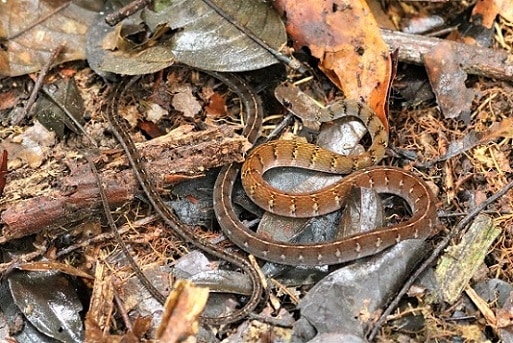
This non-venomous snake is found in northern areas of the Amazon rainforest, including eastern Ecuador, northern Brazil and Suriname. The olive forest racer (Dendrophidion dendrophis) is recognisable by its unusually large eyes, and reaches a maximum length of 118.3cm. This is mainly a ground-dwelling species, but can zip up trees in the blink of an eye.
The olive forest racer has an extremely long tail, which goes towards one purpose: escaping predators. Olive forest racers are able to detach their own tail, and will deliberately sacrifice it to allow themselves to escape. Amazingly, the tail detaches with no bleeding, just a few tiny speckles of blood. The wound somehow seals itself as though cauterised.
Olive forest racers have some variation in patterns, but they usually have a series of bars spaced at regular intervals, like in the image above. This is a frog eating snake, and in the Amazon rainforest, there’s a buffet that never runs dry.
One species they eat is the Guyana humming frog, which spends much of its time underground, but moves to the surface from March to May to reproduce. The male frogs make special croaking sounds in order to attract females, but little do they realise that the olive forest racer is also listening.
| 2 | American pipe snake |
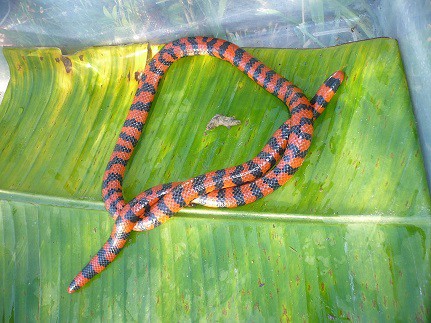
This harmless rainforest snake is isolated on the evolutionary tree, with no close relatives. The Amazon pipe snake (Anilius scytale) is a shy but widespread snake, appearing across virtually the entire Amazon region. They’re nearly always found in deep jungle areas, but you can find this species in Brazil, eastern Ecuador, French Guiana, Peru, Suriname, and many more.
The Amazon pipe snake is medium-sized, with a record length of 118.4cm, and has small black eyes. This snake is a semi-burrower, and a large chunk of its diet consists of one reptile: the Bahia slow worm, a burrower itself. They also eat other burrowing snakes, such as Tantilla melanocephala. They’re essentially the lord of a mini burrowing ecosystem, picking on the unfortunate members lower down the food chain.
Amazon pipe snakes are also one of the Amazon’s most primitive snakes, with a less evolved skull which has a similar structure to prehistoric lizards. On their lower body, they have vestigial pelvic girdles, in the form of small spurs where their legs used to be.
American pipe snakes are mainly nocturnal, and usually found on the leaf-strewn forest floor. They lack venom, and when threatened, they’ll move their tail around rhythmically, showing off the yellow underside, in order to mesmerise predators. Another primitive feature is jaws that don’t properly unhinge. This snake is unable to gape its mouth widely, and consequently, it can only swallow smaller prey.
| 3 | Taczanowski’s dwarf boa |
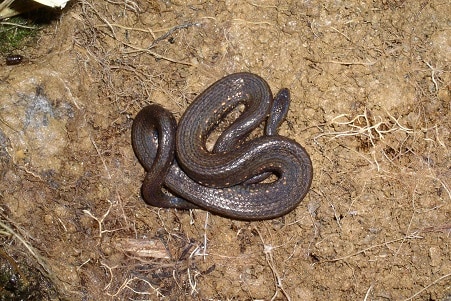
This little known boa is native to the Amazonian slopes of the Andes, in regions covered with dense forests and a constant swirling mist. They appear at elevations of 800-2900 metres, and are particularly slow-moving and lethargic. Their scales have an iridescent sheen, while their bodies are normally a muddy brown with only subtle patterns. They’re only distantly related to the boa constrictor, belonging to the 20-member Tropidophis genus instead.
This is a constricting snake, but unlike the boa constrictor, they mostly eat frogs and tadpoles. Rather than biting viciously, Taczanowski’s dwarf boas (Tropidophis taczanowskyi) have a particularly strange defensive trick. Their default is to curl up into a tight ball to defend their head, but they also use autohaemorrhaging, spewing blood from their eyes and mouth.
Tropidophis taczanowskyi is native to Peru and Ecuador, and is incredibly hard to find in its native habitats. Finding four in one day is considered to be great work, and even that’s by researchers flipping over hundreds of mossy logs laboriously. An Ecuadorian researcher not searching for Taczanowski’s dwarf boa only sees one every 4 months on average. However, this snake isn’t rare, just shy, as the majority of their pristine Ecuadorian forests are still standing. This species reaches a maximum of just 39.1cm.
| 4 | Royal marsh snake |
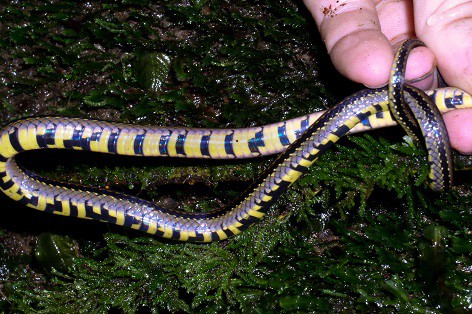
This elegant-looking snake is typically found near water bodies within rainforests. You can find royal marsh snakes (Erythrolamprus reginae) in streams, freshwater springs, and ponds covered with surface grasses, both in rainforests and rural human zones directly adjacent. This species is found in most of Brazil, Ecuador, Colombia, Bolivia, and parts of Venezuela. In fact, they’re secretly one of South America’s most widespread snakes.
The royal marsh snake is extremely reliant on amphibians, which comprise over 95% of their diet according to one study. One of their top prey is the frog Physalaemus ephippifer, while frogs’ eggs have also been found in their stomachs. It’s believed that royal marsh snakes swim towards tadpoles and swallow them up in their dozens, allowing them to eat very quickly before cunning predators take notice.
Royal marsh snakes like to ambush their prey while sleeping. They’re a day-faring snake, while most of their prey is nocturnal, and so they spend their days slithering along the moist forest floor, probing secret entrances, hoping to find frogs unconscious in their hollows. Erythrolamprus reginae reaches a maximum of 81.0cm, and often has green tinges, while their belly is a creamy colour with black squares. Their eyes sometimes have glints of red.
| 5 | Graceful snail eater |
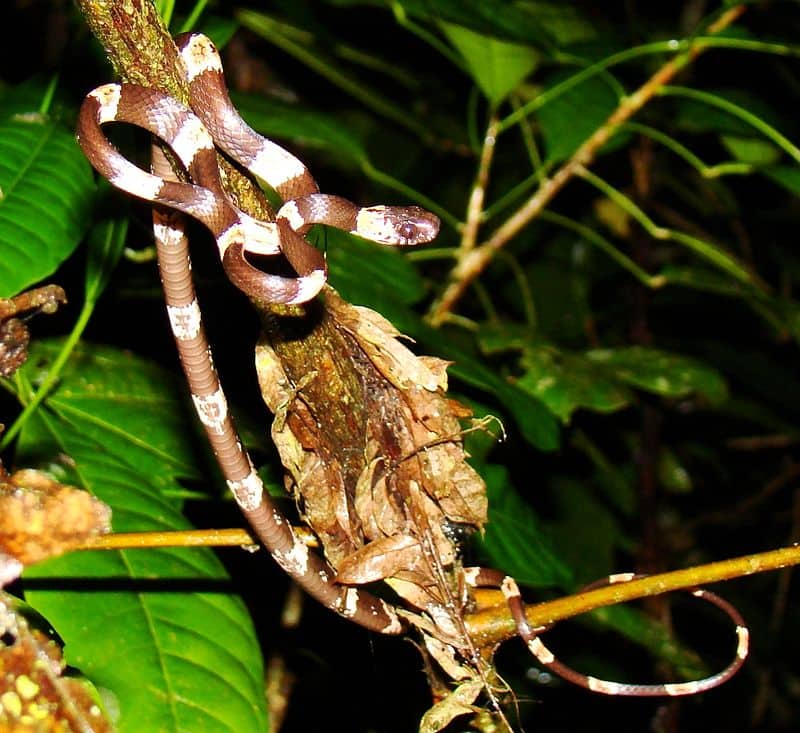
This Amazonian snake is usually found curled up on shrubs 20-50cm above ground. Nobody knows whether their graceful title comes from their colours, or whether they suck down their snails elegantly like in a fine banquet. Either way, snails form the majority of this snake’s diet (plus some slugs). Their technique is simple: grip the shells firmly and suck the body free over several minutes.
There are many Dipsas snail eater species in South America, but Dipsas gracilis is separated from its neighbours by its darker head. Their maximum length is 81.9cm, and their eyes are particularly large and bulging. Graceful snail eaters particularly enjoy rain and drizzle; any form of precipitation rouses them from their doziness and causes them to re-enter the hunt. Their temperament may also be behind their name, as this Amazonian snake never bites people even when scooped up. The most they do is release an intolerable smell.
This is the kind of shy snake that might accidentally vanish without a trace one day, but graceful snail eaters still have a healthy global population. Large swathes of their forest are intact in Ecuador and Columbia, and they exist in 21 protected ecological zones.
| 6 | Toad-headed pitviper |
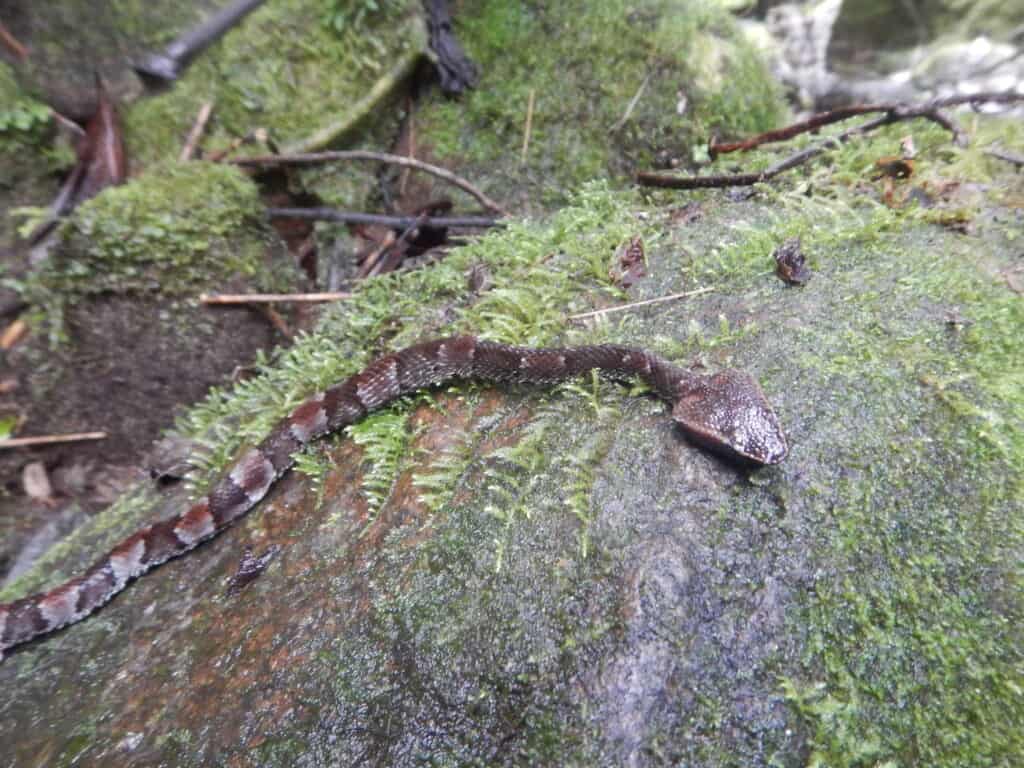
This venomous snake has a massive, triangular head, and equally massive fangs. The toad-headed pitviper (Bothrocophias microphthalmus) is mainly found in eastern Ecuador and Peru, and is believed to cause 1.5% of snakebites in certain regions. They reach a maximum of 132cm, and are plentiful in rainforests, particularly close to streams and rivers. They also stray into nearby cassava plantations. Data is lacking for this snake, but its close relative B. hyoprora can kill a dog in 2 hours and a child in 7 hours.
Fortunately, toad-headed pitvipers are quite calm, as their camouflage is extremely effective in fallen leaves. It can take great concentration to spot one in a photograph. Consequently, they assume that they’re safe from attention, but the flipside is that when they do get unnerved, they sometimes attack without warning. In other encounters, they’ll swish their tail from side to side and make a warning noise with the leaves.
Toad-headed pitvipers are nocturnal, and use ambush to hunt. Their diet is very wide, including frogs, rodents, geckos, and opossums alike. Their signature X-shaped patterns are one way to recognise them. The best way to find this species (if you have a death wish) is by walking forest trails at night. In some cases, this happens to villagers accidentally.
| 7 | Aquatic coral snake |
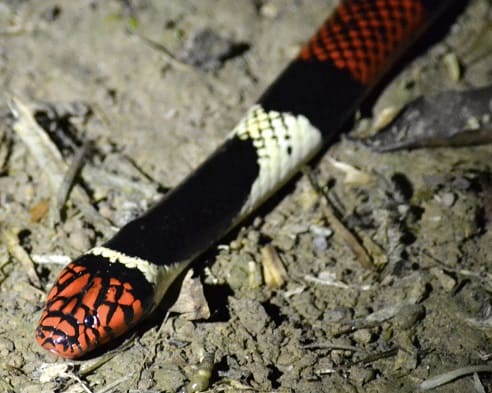
One of over 80 Micrurus coral snake members in the Americas. However, this species has unique aquatic adaptions, including eyes and nostrils that are oriented upwards, to provide superior sight and smell as they swim. Aquatic coral snakes are actually semi-aquatic, as they usually inhabit streams, lagoons, swamps, and slow-moving rivers within rainforests, but also appear on forest floors during the dry season. They also pop up in gardens and houses near the borders of rainforests.
Aquatic coral snakes are simple to recognise, with a sharply contrasting black and red head. Instead of fellow snakes like most of their cousins, aquatic coral snakes feed on fish and eels, which they search for by swimming along the water surface, constantly scanning their surroundings for any flicker of prey.
This species has an extremely potent venom, with an LD50 score of 0.2-0.4mg, far outstripping a cottonmouth or copperhead. The symptoms in humans include blurred vision, muscular paralysis and trouble breathing. However, tests reveal that the venom is specialised against fish, and far weaker in mammals and reptiles. This snake is a focussed machine, optimised for Amazon rainforest rivers, which reaches a maximum confirmed length so far of 139cm.
| 8 | Chironius grandisquamis |
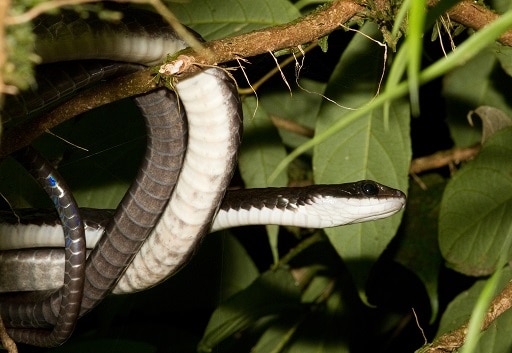
The Amazon rainforest has an endless supply of obscure streams, the short of shallow rocky streams you can easily cross in your waterproof boots. Look up while crossing these streams, and there’s a good chance you’ll see Chironius grandisquamis staring down at you. This is a large black snake with a maximum length of 271.8cm, which begins life as brown and darkens steadily over its life. This contrasts sharply with a pristine white belly, making this an easy rainforest snake to recognise.
Chironius grandisquamis is most often spotted while curling up on a thin branch, and they particularly favour branches over water. When disturbed by researchers, they sometimes drop off these branches and hide beneath underwater rocks. Chorinius grandisquamis can stay underwater for 15 minutes when threatened.
This species is found in Ecuador and Colombia, and prefers humid rainforests with high rainfall totals. They sometimes rest on branches in pairs, not interacting, but coexisting calmly. Their diet is mysterious, but frogs are confirmed, with one species being the northern rainfrog (Craugastor metriosistus). They forage by day, and return to their branches at night.
This rainforest dweller lacks venom, but has several surprise tricks at its disposal. They can flee, bite savagely, or release a foul snake smell which forces you to drop them. You won’t see this snake in a hotel lobby; it only lives far from civilisation, in obscure Amazon pathways that few will ever lay eyes on.
| 9 | Atractus elaps |
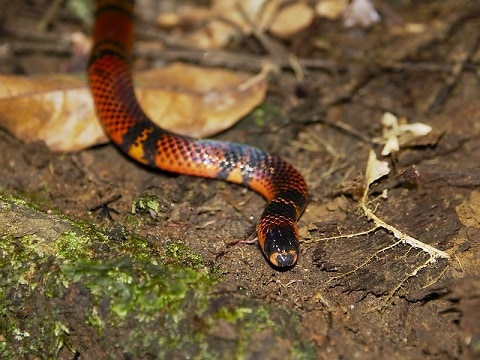
The Atractus snake genus has over 100 members in the western hemisphere, and Atractus elaps is the ruling species of the far western Amazon, particularly Ecuador. This non-venomous snake often inhabits overgrown farmland next to forests, but is most common within rainforests themselves. This is a small snake at an average of 50cm for males (females slightly shorter), and a record of 62.6cm. Their heads are shiny black from above, which contrasts with a bright red neck collar.
Atractus elaps has a particularly colourful belly, with orange, red and yellow all being possibilities. These colours are extremely similar to venomous coral snakes, so it’s believed that this humble snake evolved to mimic these deadly neighbours and therefore guarantee itself a shield. When threatened, Atractus elaps rolls itself up into a tight ball, protecting the head, and raises its tail high in the air to show off its colours. Two of its common names are Tierrera coral, or coral ground snake. The disguise is so effective that farmers usually kill them out of fear.
This species is also common in eastern Colombia, on the slopes of the Andes. Their main foodstuff is earthworms, and consequently, Atractus elaps lives primarily in the upper layers of decomposing forest matter, rich in leaves and rotting logs. This species reaches a record of 62.6cm.
| 10 | Machete savane |
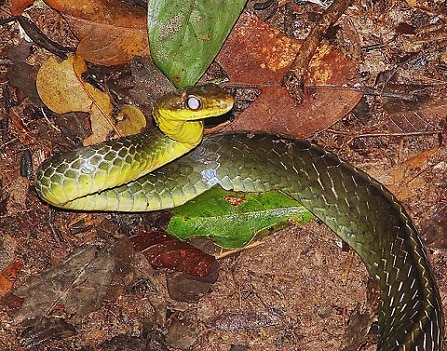
One of the longer snakes in the Amazon rainforest. Also called the Amazon whipsnake, this species has a very thin body, but can reach lengths of 205.4cm. Hatchlings begin life at 46cm. This is a branch-dwelling species, and their relatively long length makes crossing between overlapping branches much easier.
The machete savane is widespread, appearing in Brazil, Ecuador, and Costa Rica. Their colours vary from brown to green-tinged (like above). However, this species always has one defining feature: a sharp ridge of scales running down its spine. Machete savanes don’t seem to realise how huge they are, as they often act shy, kinking their long bodies into weird shapes in order to disguise themselves as sticks on the forest floor. They sometimes grip branches with their tails and dangle their long bodies down like a vine.
When spooked, machete savanes sometimes flee into water at top speeds, never to be seen again, but they’re unpredictable, and sometimes lunge forward with a savage (though venomless) bite instead. Chironius carinatus is also able to inflate its neck like a cobra. These tricks regularly come in use, as machete savanes are known to be hunted by laughing falcons. This species moves by day, and has a wide diet, with birds, reptiles and frogs all on the table.
